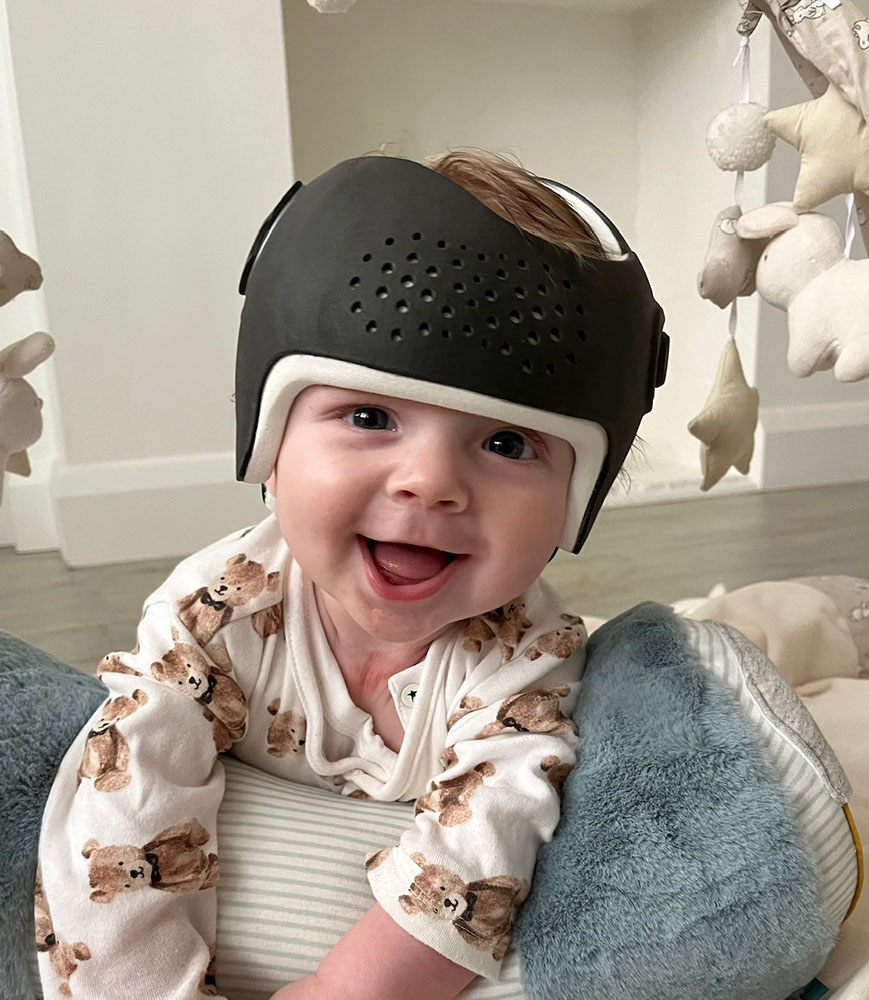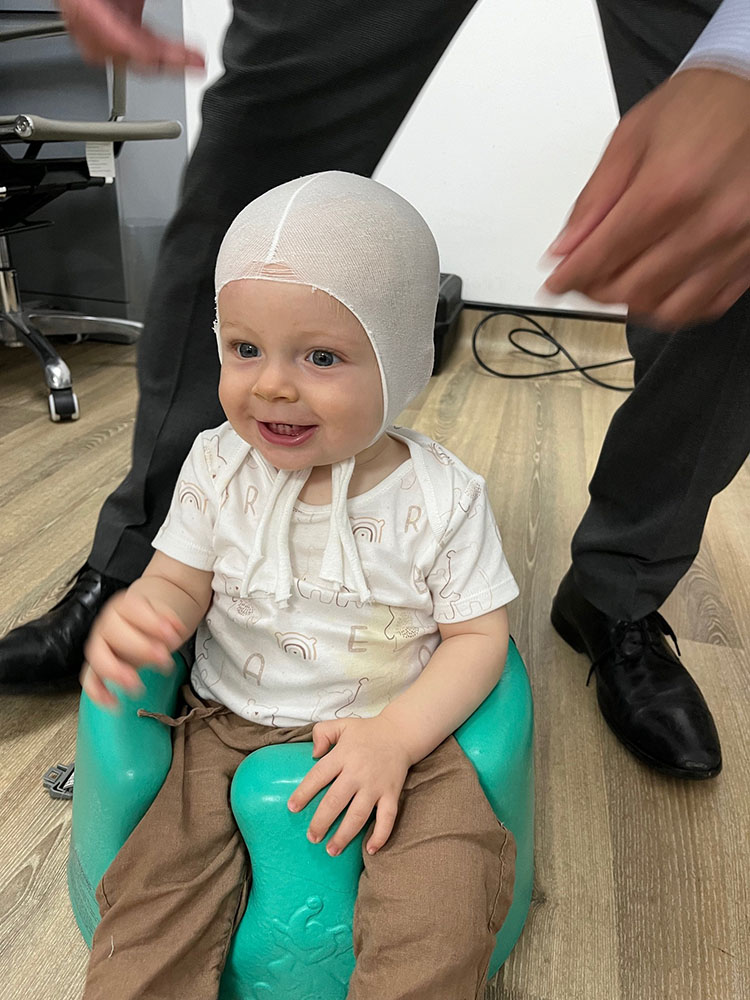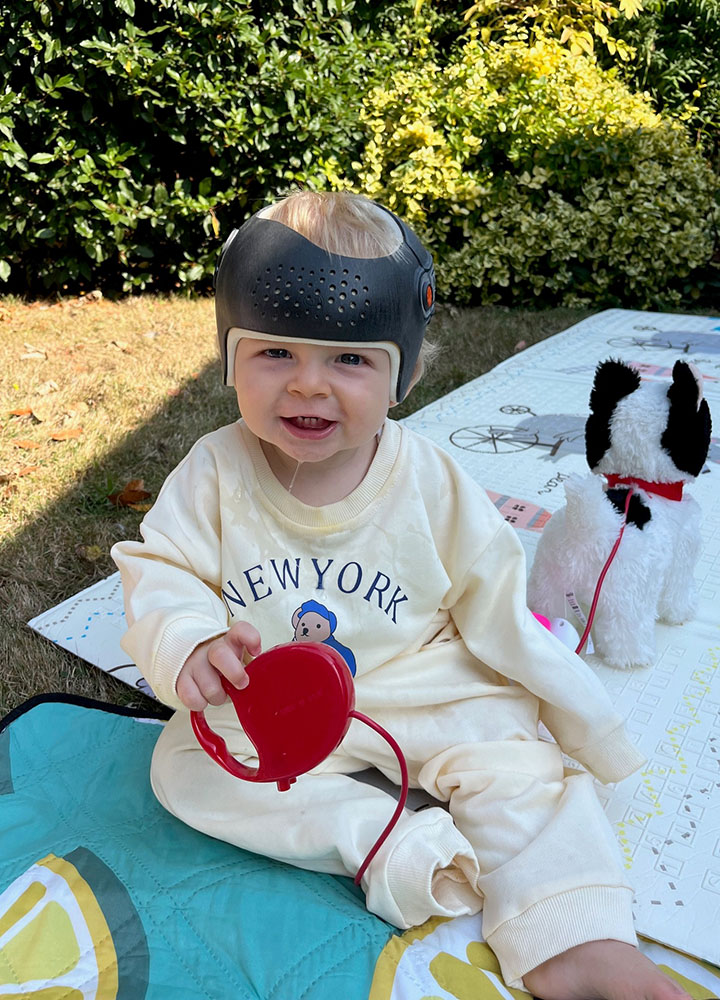
Luca in his LOCband Lite during treatment
14 November 2024
Luca’s mother, Lauren, first noticed something was wrong with his head shape when he was about three months old. There were no problems at birth. “It was really ironic as my partner and I were really enjoying the fact that Luca slept so soundly; this was in direct contrast to his older sister, who kept us awake all night. Because he slept so well, he stayed in the same position for long periods of time, thus causing his flat head, as I subsequently found out.”
As Lauren didn’t know what the problem was originally, she searched online and tried special pillows. When there was no improvement, she went to her GP, who agreed that Luca’s head was flat and was flat enough to be referred to a consultant.
In the meantime, she received a recommendation to talk to the London Orthotic Consultancy from a friend’s sister-in-law who knew somebody whose baby had been treated by LOC. The GP’s confirmation of the diagnosis provided Lauren with the motivation to contact us.

Luca during his head scanning appointment
The LOCband is non-invasive and works by applying gentle, constant pressure over the areas of the baby’s skull that are most prominent while allowing unrestricted growth over the flattened areas. The band consists of a soft foam layer inside a thermoplastic shell. As the baby grows, the band will be adjusted frequently to gently guide the skull into a more symmetrical shape.
The optimum age for treatment is between four and seven months.
This is because the skull is most malleable at this age and improvements to head shape tend to take less time and are more dramatic. That is not to say that helmet therapy should be ruled out if the baby is older than seven months. Routinely, babies up to the age of 16 months can be treated very successfully.
The cut off age is around 18 months when the fontanelles (soft spots on the head) are no longer malleable. As babies grow and develop at different rates, it is always worth checking if you are not sure. There have been cases where a baby’s fontanelles have not fused yet by the age of 18 months, who have achieved successful, but less-marked results with cranial remoulding therapy.
Yes - All babies that have completed their course of treatment with us have achieved a measurable improvement in head shape. However, you don’t have to take our word for it.
Recent independent research conducted by a University Hospital in Germany has endorsed the treatment for babies with moderate or severe plagiocephaly.
A larger, retrospective study has just been published that found complete correction was achieved in 94.4% of babies treated with helmet therapy.
The results were conclusive: repositioning achieved acceptable correction in 77.1% of cases, but 15.8% were moved onto helmet therapy because re-positioning was not working. Meanwhile, 94.4% of the infants who started in the helmet-treated group achieved full correction, as did 96.1% of those who were transferred from the repositioning group into the helmet-treated group.
Further information can be found on our Plagiocephaly Research page.
This is very much dependent on how fast your baby is growing. The faster the growth, the more frequently your baby will be seen so that the helmet can be adjusted. In general, reviews will happen at two to four-week intervals.
The price of treatment covers:
Luca was assessed by Saeed Hamid, one of LOC’s founders, at our Romford clinic in February of this year. Saeed confirmed that Luca had moderate to severe brachycephaly.
Brachycephaly is a condition where the skull is shorter than typical, causing the head to appear disproportionately wide or broad in relation to its depth. The term comes from the Greek words "brachy-" (short) and "cephaly" (head). It is a type of cranial deformation that affects the shape of the skull, typically resulting in a flatter back of the head.

Luca's asymmetry went from 12mm at the start of treatment to 2mm at his discharge appointment.
One of the objective determinants of the severity of a baby’s head shape is what is called the cranial vault asymmetry. Luca’s asymmetry was 12 mm; this measurement compares the right and left diagonals at 30 degrees from the centre of the head (front to back) and subtracting one from the other gives the asymmetry value.
Less than 6mm is regarded as being within the normal range of head shape, anything over 12mm is considered severe. The second measurement that is used to determine the severity of the condition is the cephalic ratio; this measures the width of the skull divided by the length of the skull. The top end of the normal range is 89%, Luca’s was 99%.

Luca in his helmet over the summer
Luca was fitted with his cranial remoulding helmet, the 3D-printed LOCband Lite, two weeks after his assessment. Lauren recalls: “Saeed was brilliant, informative and reassuring in equal measure, the whole process seemed seamless. Luca had no problems with the helmet and took to it very well. It even acted as a little crash helmet when he was playing with his sister on our hard wooden floors!!” At discharge from treatment in September, Luca’s cranial asymmetry had been reduced to 2 and the cephalic ratio to 92.
Lauren concludes: “We are so pleased with the treatment and brilliant results; Saeed always managed to see us for face-to-face review appointments when we wanted one. You cannot fault the treatment or the service provided by LOC. We never did hear back from our GP.”
If you’re worried about your baby’s head shape, get in touch today. You can fill out our free flat head diagnosis form or, to book a free consultation with a clinician, contact us.